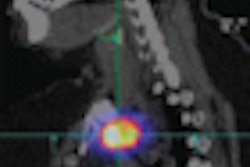A Belgian study has shed additional light on the amount of radiation dose delivered to infants in neonatal intensive care units (NICUs) in the country. The research provides reference values for radiation dose in the NICU environment, and also offers guidance on collecting radiation dose measurements and converting them into organ-dose values.
As an increasing number of infants born before 37 weeks of gestation survive, the number of premature infants with underdeveloped lungs who are susceptible to respiratory distress syndrome or to lethal lung hypoplasia/hypertension is also increasing. Because diagnoses of these conditions are made by radiography, researchers at University Hospitals Leuven conducted a year-long survey to determine the frequency, type, and dose of chest x-rays of premature infants in its NICU.
The researchers wanted to establish a formal protocol for calculating patient dose by measuring entrance skin dose and dose area product, and converting the values to organ dose. They also wanted to compare their findings with a previous European multicenter study that revealed a large spread in dose values. Findings from the current study were published online in Radiation Protection Dosimetry (August 30, 2008, Vol. 131:1, pp. 143-147).
From September 2004 through August 2005, 255 infants were admitted to the 37-bed NICU. A total of 2,452 diagnostic imaging procedures were performed.
|
On average, each infant had 10 x-ray exams using a mobile x-ray unit (Mobilett, Siemens Healthcare, Erlangen, Germany), and one infant had 78 exams. However, the majority of infants had no more than five x-ray exams while in the NICU.
The median entrance skin dose was 34 μGy, medical physicist and lead author Dr. Kristien Smans reported. By comparison, the entrance skin dose of children younger than 12 months of age reported in the European multicenter study ranged from 41 μGy to 353 μGy.
The researchers defined entrance skin dose as the absorbed dose at the point of intersection of the x-ray beam axis with the entrance surface of the infant, including backscattered radiation. It was measured by placing thermoluminescent dosimeters on the skin of the patient, with a correction of 1.1 for energy dependence applied.
The median entrance skin dose was calculated for the following groups:
- Infants weighing less than 1,000 g, or extremely low-birth-weight infants (median 28 μGy, range 21-34 μGy)
- Infants weighing from 1,000 g to 2,500 g, or low-birth-weight infants (median 33 μGy, range 3-75 μGy)
- Infants weighing more than 2,500 g, or normal-birth-weight infants (median 52 μGy, range 26-101 μGy)
The dose area product (DAP) was defined as the product of dose and irradiated area, collimated to the region of interest. The median DAP value was 7.1 mGy.cm2.
Organ dose calculations for infants weighing less than 2,500 g were calculated with conversion coefficients of two voxel phantoms developed by Smans and using a full-term baby phantom for normal-weight infants. Radiation dose to the lung ranged from 24.5 μGy for the extremely low-birth-weight infant, to 24.9 μGy for the low-birth-weight infant, to 31.7 μGy for the normal-birth-weight infant. Calculations were also performed for bone, heart, liver, and thymus.
"The importance of this study is that it provides reference values for cumulated doses, and provides detailed instruction on how to measure patient doses in practice and convert the measurements into organ doses about premature infants for whom standard baby phantoms are not applicable," Smans said.
"A physician ordering a radiology exam for a newborn needs to remember that this patient is particularly sensitive to the detrimental effects of radiation," she said. "The risk of cancer induction per unit of dose is believed to be two to three times higher than that of the average population and six to nine times higher than the risk from an exposure at 60 years of age."
By Cynthia Keen
AuntMinnie.com staff writer
January 8, 2009
Related Reading
Studies examine digital methods for reducing pediatric x-ray dose, October 9, 2007
'Instant replay' fluoroscopy cuts radiation dose in children, January 9, 2007
Flat-panel detectors cut radiation dose in angiography, pediatric chest x-rays, November 4, 2005
Report finds vendors enable excess radiation doses in pediatric CR, DR, February 4, 2005
Copyright © 2009 AuntMinnie.com


















